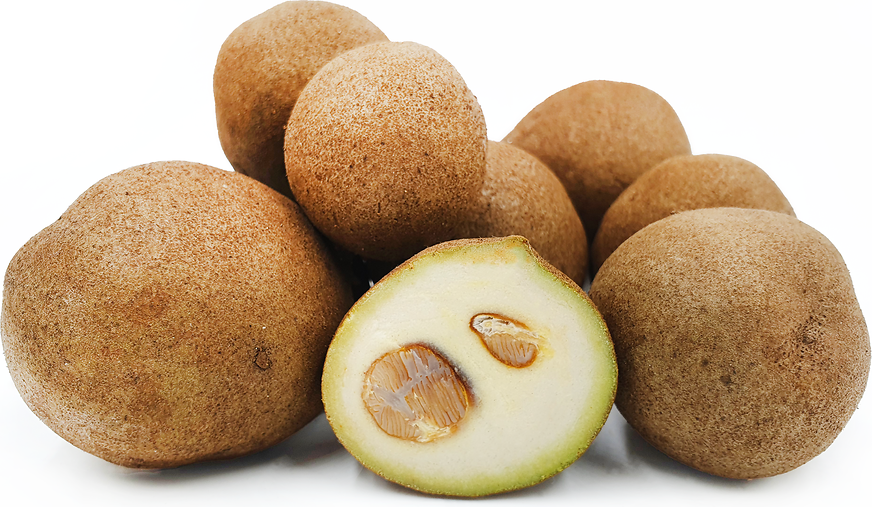


Kepel Fruit
Estimated Inventory, lb : 0
Description/Taste
Kepel fruits are small to medium-sized, averaging 3 to 6 centimeters in diameter, and have an oval to round shape. The skin is leathery, textured, and slightly rough, transitioning from green to yellow-brown when mature, and the fruits ripen over a period of six months. Underneath the surface, the flesh has a creamy, semi-aqueous, and smooth consistency and is green when young, developing yellow-orange hues when ripe. The flesh also encases 4 to 6 large, oval, and light brown seeds. To determine when the fruit is ripe, the skin can be lightly scratched. If the scratched portion reveals a green hue, the fruit is still immature, but if it is orange, the fruit is ready to be harvested. Kepel fruits are aromatic and have a sweet, fruity, and tropical flavor with papaya, mango, and coconut undertones.
Seasons/Availability
Kepel fruits are available year-round in Southeast Asia.
Current Facts
Kepel fruits, botanically classified as Stelechocarpus burahol, grow on an evergreen, tropical tree belonging to the Annonaceae family. The variety is native to Southeast Asia and is favored as an ornamental, producing dark green and red, glossy leaves and brightly colored flowers that decorate the tree's trunk. Hundreds of fruits also grow directly from the tree's lower trunk, giving the tree an unusual, enveloped appearance. Despite their ornamental nature, Kepel fruit trees are an endangered species as most of the trees in Southeast Asia have been cut down for urban development. The fruits were also once reserved for royalty, and it was forbidden to consume the fruits for hundreds of years. Eventually, in the 1970s, the fruits were permitted for widespread consumption, but many traditional families still viewed the fruits as off-limits, leading to many trees being cut down. In the modern-day, Kepel fruits are rare, scarcely sold in local markets, and are foraged from the remaining trees for fresh consumption. Efforts are also being made to replant the variety, but Kepel fruit trees are slow-growing, taking over 8 to 10 years to fruit, which has reduced repopulation efforts.
Nutritional Value
Kepel fruits are a good source of vitamin C to strengthen the immune system, reduce inflammation, and boost collagen production within the skin. The fruits also contain vitamin A to help protect against vision loss and maintain healthy organ functioning. In Indonesia, Kepel fruits are used as a natural diuretic to cleanse the kidneys and as an anti-aging ingredient.
Applications
Kepel fruits are best consumed fresh as the sweet, tropical flesh is showcased when eaten straight, out-of-hand. It is important to note that only ripe fruits should be consumed as unripe fruits bear an unpalatable, sour, and bitter quality. When ripe, the fruits should be rolled between the palms to soften the flesh, sliced in half, and the flesh can be scooped with a spoon. The flesh is the only element of the fruit eaten, and the seeds and skin are typically discarded. Beyond fresh eating, Kepel fruits are sometimes blended into juices, smoothies, and beverages or used as a fresh topping over salads, porridge, and desserts. Kepel fruits will keep 2 to 3 weeks when stored at room temperature away from direct sunlight.
Ethnic/Cultural Info
Kepel fruits are the official emblem of the Yogyakarta Special Region in Southern Java, an area ruled by the only recognized monarchy in Indonesia. Since ancient times, Kepel fruits were primarily consumed by royalty, and the fruits were forbidden to be eaten by non-royal residents. Members of the royal household believed the fruits gave sweat, breath, fecal matter, and urine a floral, violet-like smell, and the fruits were also consumed by females as a natural fertility inhibitor. With these unusual odor-fighting properties, the fruits widely increased in popularity, and the fruits became a symbol throughout Indonesia of strength, hospitality, and royalty. Kepel fruit trees can still be seen throughout the palace gardens in the present day and are featured at the entrance of the palace gates. The fruit trees are also planted in the Mekarsasi Fruit Park and Bogor Botanical Garden.
Geography/History
Kepel fruits are native to Southeast Asia and have been growing wild since ancient times. The trees thrive in humid, tropical forests and are found in limited numbers in Indonesia and Malaysia. Kepel fruits have also been introduced to India, the Solomon Islands, the Philippines, Australia, South America, and Florida. The trees are considered endangered due to deforestation and are being cultivated on a small scale in an effort to regrow the population. Today Kepel fruits are primarily foraged from wild trees and are sometimes found in local markets throughout Central Java.




